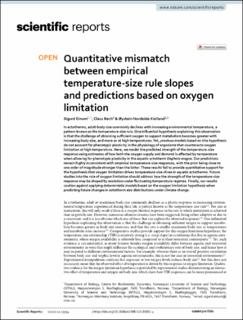| dc.contributor.author | Einum, Sigurd | |
| dc.contributor.author | Bech, Claus | |
| dc.contributor.author | Kielland, Øystein Nordeide | |
| dc.date.accessioned | 2023-02-22T11:03:02Z | |
| dc.date.available | 2023-02-22T11:03:02Z | |
| dc.date.created | 2022-01-03T16:09:18Z | |
| dc.date.issued | 2021 | |
| dc.identifier.citation | Scientific Reports. 2021, 11 (1), 1-7. | en_US |
| dc.identifier.issn | 2045-2322 | |
| dc.identifier.uri | https://hdl.handle.net/11250/3053179 | |
| dc.description.abstract | In ectotherms, adult body size commonly declines with increasing environmental temperature, a pattern known as the temperature-size rule. One influential hypothesis explaining this observation is that the challenge of obtaining sufficient oxygen to support metabolism becomes greater with increasing body size, and more so at high temperatures. Yet, previous models based on this hypothesis do not account for phenotypic plasticity in the physiology of organisms that counteracts oxygen limitation at high temperature. Here, we model the predicted strength of the temperature-size response using estimates of how both the oxygen supply and demand is affected by temperature when allowing for phenotypic plasticity in the aquatic ectotherm Daphnia magna. Our predictions remain highly inconsistent with empirical temperature-size responses, with the prior being close to one order of magnitude stronger than the latter. These results fail to provide quantitative support for the hypothesis that oxygen limitation drives temperature-size clines in aquatic ectotherms. Future studies into the role of oxygen limitation should address how the strength of the temperature-size response may be shaped by evolution under fluctuating temperature regimes. Finally, our results caution against applying deterministic models based on the oxygen limitation hypothesis when predicting future changes in ectotherm size distributions under climate change. | en_US |
| dc.language.iso | eng | en_US |
| dc.publisher | Springer Nature | en_US |
| dc.rights | Navngivelse 4.0 Internasjonal | * |
| dc.rights.uri | http://creativecommons.org/licenses/by/4.0/deed.no | * |
| dc.title | Quantitative mismatch between empirical temperature-size rule slopes and predictions based on oxygen limitation | en_US |
| dc.title.alternative | Quantitative mismatch between empirical temperature-size rule slopes and predictions based on oxygen limitation | en_US |
| dc.type | Peer reviewed | en_US |
| dc.type | Journal article | en_US |
| dc.description.version | publishedVersion | en_US |
| dc.subject.nsi | VDP::Økologi: 488 | en_US |
| dc.subject.nsi | VDP::Ecology: 488 | en_US |
| dc.subject.nsi | VDP::Økologi: 488 | en_US |
| dc.subject.nsi | VDP::Ecology: 488 | en_US |
| dc.source.pagenumber | 1-7 | en_US |
| dc.source.volume | 11 | en_US |
| dc.source.journal | Scientific Reports | en_US |
| dc.source.issue | 1 | en_US |
| dc.identifier.doi | 10.1038/s41598-021-03051-y | |
| dc.identifier.cristin | 1973895 | |
| dc.relation.project | Norges forskningsråd: 223257 | en_US |
| dc.relation.project | Norges forskningsråd: 230482 | en_US |
| cristin.ispublished | true | |
| cristin.fulltext | original | |
| cristin.qualitycode | 1 | |

